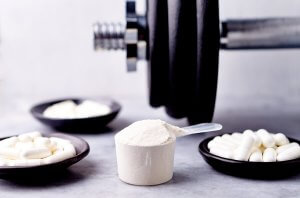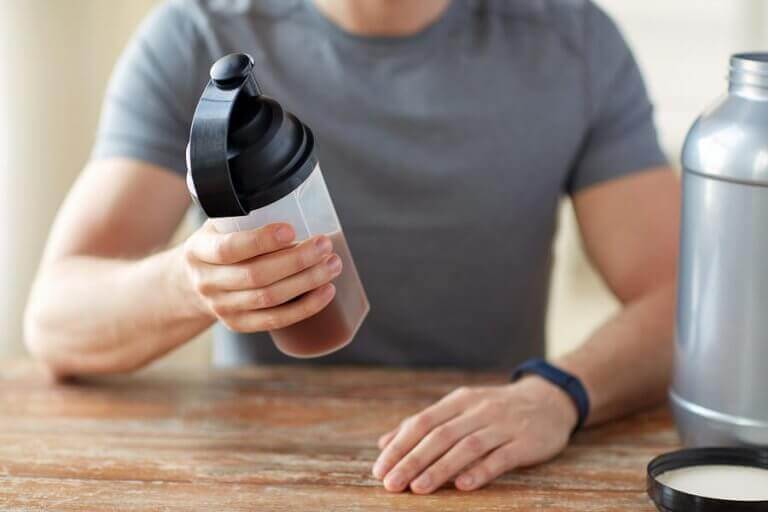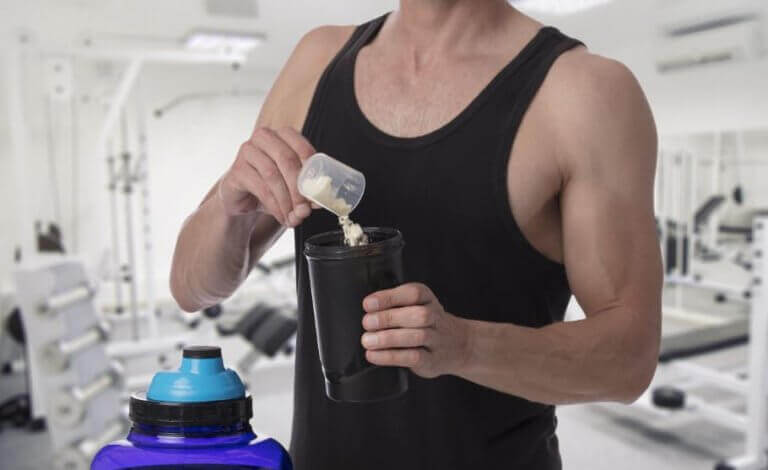Supplementing with Creatine: Does it Work?

Creatine is one of the most known and studied supplements. As a matter of fact, there are over 1,800 studies published about it. Nowadays, supplementing with creatine is very common within the sports world. Is it really effective?
What is creatine?
Creatine is an inorganic nitrogenous compound that’s naturally present in animal muscles, for example, meat and fish. We can usually get one to two grams every day through our diets, which is equivalent to half of our daily needs.
The pancreas, liver, and kidneys can also synthesize creatine from its amino acid precursors: arginine, glycine, and methionine.
History
Its chemical name is methylguanidoacetic acid, discovered in 1882 by Michel Eugene Chevreul and commercialized half a century later. During the nineties, athletes began to use it in the Barcelona Olympics due to a comment from professor Roger Harris. He claimed that “supplementing with creatine could increase the intramuscular concentrations of creatine”.
Nowadays, the United States consumes four million kilograms (almost 9 million pounds) of creatine per year. And the consumption is even bigger on a world scale. In athletes and the military population, the prevalence of creatine supplementation is between 14 and 40 percent.
Supplementing with creatine: why use it?
Performance and body composition
Especially in sports of strength, supplementing with creatine improves the capacity for intense exercise and adaptation to training in teens, young adults and the elderly. In this context, the goal of supplementation is to saturate the deposits of phosphocreatine, which is the source of energy used during the first ten seconds of effort.

As for sports of endurance, it seems to also have a positive effect. However, there’s not enough literature yet. We need more studies with protocols and quantities.
Injury prevention and recovery
Muscular creatine decreases by 24 percent during periods of extreme inactivity, such as immobilization. Supplementing certainly does work during that inactivity process.
Besides that, supplementing with creatine can help to diminish muscular atrophy after immobilization and promote recovery during rehabilitation.
Creatine as a neuroprotector
Supplementing with creatine improves performance on some cognitive tests, especially under stressful conditions. However, the effective dose to increase brain creatine isn’t the same as needed to increase muscle creatine. Some people believe that a bigger dose, maintained for a longer period of time, is what we really need.
Thermoregulation
Supplementation can be an efficient strategy for nutritional hyperhydration for athletes that perform intense workouts in warm and humid environments. This way, it reduces the risk of diseases related to elevated temperatures.
Therapeutic use of creatine supplementation
Some have proposed using creatine in therapies against diseases such as Huntington or Parkinson, because of the activity it has on the central nervous system (CNS).
Using it as an aid to prevent the loss and to increase or regenerate muscle mass has also become quite popular. And, it can help elderly people with age-related disorders such as sarcopenia or muscular dystrophy.
In combination with strength training, this form of supplementation can mitigate the adverse changes related to sarcopenia. In particular, studies have shown that supplementing with creatine during physical exercises can have a positive influence on our body composition, strength, and endurance; the effect is greater than the one we get from physical exercise on its own.
The right way of supplementing with creatine
First, you must have an idea of your creatine levels and take into account other factors such as your age and diet. For example, vegetarians have lower creatine levels, but their activity is higher, which is why they respond better to supplementation.

The classic protocol consists of taking 20 grams (or 0.7 ounces) of creatine for five days (loading phase). After that, keep your intake at around 3 grams (or 0.1 ounces) per day during the maintenance stage. There’s another protocol with only one stage that requires 3-6 grams of creatine per day (0.1-0.2 ounces).
Creatine cycling won’t be something you need to do; there are no studies that show otherwise. However, periodization of not only carbs, but supplements as well, is becoming a matter of common sense in sports nutrition.
The safety of supplementing with creatine
Creatine is a safe supplement. As a matter of fact, the only described side effect is weight gain. Keep this weight gain into account when creating a nutritional program that includes creatine, depending on the sport you want to practice.
People who practice long jumps, pole vaulting or other sports that categorize competitors by weight, should be careful about the correct time to take creatine so that the loading phase doesn’t coincide with their competition.
Creatine is one of the most known and studied supplements. As a matter of fact, there are over 1,800 studies published about it. Nowadays, supplementing with creatine is very common within the sports world. Is it really effective?
What is creatine?
Creatine is an inorganic nitrogenous compound that’s naturally present in animal muscles, for example, meat and fish. We can usually get one to two grams every day through our diets, which is equivalent to half of our daily needs.
The pancreas, liver, and kidneys can also synthesize creatine from its amino acid precursors: arginine, glycine, and methionine.
History
Its chemical name is methylguanidoacetic acid, discovered in 1882 by Michel Eugene Chevreul and commercialized half a century later. During the nineties, athletes began to use it in the Barcelona Olympics due to a comment from professor Roger Harris. He claimed that “supplementing with creatine could increase the intramuscular concentrations of creatine”.
Nowadays, the United States consumes four million kilograms (almost 9 million pounds) of creatine per year. And the consumption is even bigger on a world scale. In athletes and the military population, the prevalence of creatine supplementation is between 14 and 40 percent.
Supplementing with creatine: why use it?
Performance and body composition
Especially in sports of strength, supplementing with creatine improves the capacity for intense exercise and adaptation to training in teens, young adults and the elderly. In this context, the goal of supplementation is to saturate the deposits of phosphocreatine, which is the source of energy used during the first ten seconds of effort.

As for sports of endurance, it seems to also have a positive effect. However, there’s not enough literature yet. We need more studies with protocols and quantities.
Injury prevention and recovery
Muscular creatine decreases by 24 percent during periods of extreme inactivity, such as immobilization. Supplementing certainly does work during that inactivity process.
Besides that, supplementing with creatine can help to diminish muscular atrophy after immobilization and promote recovery during rehabilitation.
Creatine as a neuroprotector
Supplementing with creatine improves performance on some cognitive tests, especially under stressful conditions. However, the effective dose to increase brain creatine isn’t the same as needed to increase muscle creatine. Some people believe that a bigger dose, maintained for a longer period of time, is what we really need.
Thermoregulation
Supplementation can be an efficient strategy for nutritional hyperhydration for athletes that perform intense workouts in warm and humid environments. This way, it reduces the risk of diseases related to elevated temperatures.
Therapeutic use of creatine supplementation
Some have proposed using creatine in therapies against diseases such as Huntington or Parkinson, because of the activity it has on the central nervous system (CNS).
Using it as an aid to prevent the loss and to increase or regenerate muscle mass has also become quite popular. And, it can help elderly people with age-related disorders such as sarcopenia or muscular dystrophy.
In combination with strength training, this form of supplementation can mitigate the adverse changes related to sarcopenia. In particular, studies have shown that supplementing with creatine during physical exercises can have a positive influence on our body composition, strength, and endurance; the effect is greater than the one we get from physical exercise on its own.
The right way of supplementing with creatine
First, you must have an idea of your creatine levels and take into account other factors such as your age and diet. For example, vegetarians have lower creatine levels, but their activity is higher, which is why they respond better to supplementation.

The classic protocol consists of taking 20 grams (or 0.7 ounces) of creatine for five days (loading phase). After that, keep your intake at around 3 grams (or 0.1 ounces) per day during the maintenance stage. There’s another protocol with only one stage that requires 3-6 grams of creatine per day (0.1-0.2 ounces).
Creatine cycling won’t be something you need to do; there are no studies that show otherwise. However, periodization of not only carbs, but supplements as well, is becoming a matter of common sense in sports nutrition.
The safety of supplementing with creatine
Creatine is a safe supplement. As a matter of fact, the only described side effect is weight gain. Keep this weight gain into account when creating a nutritional program that includes creatine, depending on the sport you want to practice.
People who practice long jumps, pole vaulting or other sports that categorize competitors by weight, should be careful about the correct time to take creatine so that the loading phase doesn’t coincide with their competition.
All cited sources were thoroughly reviewed by our team to ensure their quality, reliability, currency, and validity. The bibliography of this article was considered reliable and of academic or scientific accuracy.
- Hall M, Trojian TH. 2013. Creatine supplementation. Current sports medicine reports, 12(4), 240-244
- Kreider RB, Kalman DS et al. 2017. International Society of Sports Nutrition position stand: safety and efficacy of creatine supplementation in exercise, sport, and medicine. Journal of the International Society of Sports Nutrition, 14(1), 18
- Farshidfar F, Pinder M et al. 2017. Creatine supplementation and skeletal muscle metabolism for building muscle mass-review of the potential mechanisms of action. Current Protein and Peptide Science, 18(12), 1273-1287
This text is provided for informational purposes only and does not replace consultation with a professional. If in doubt, consult your specialist.








